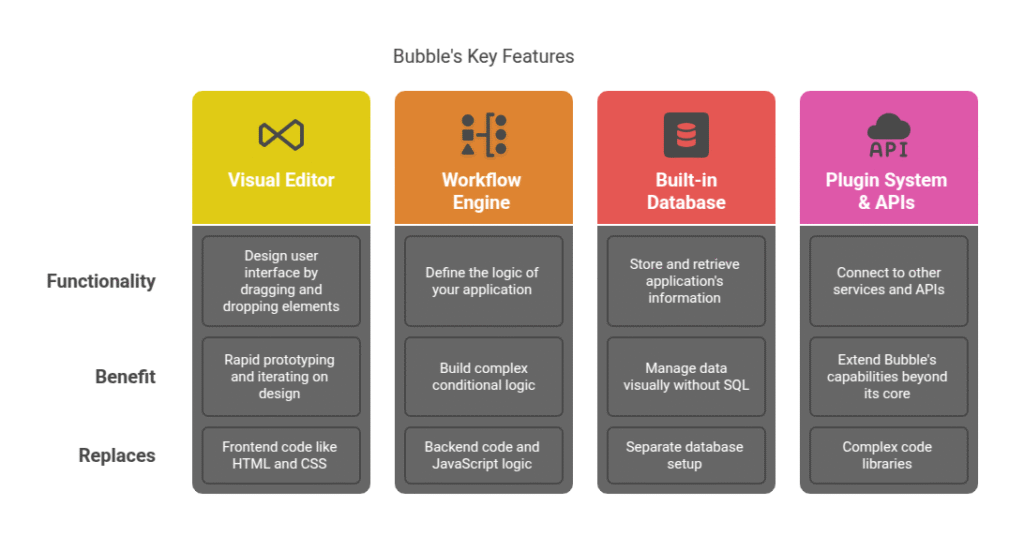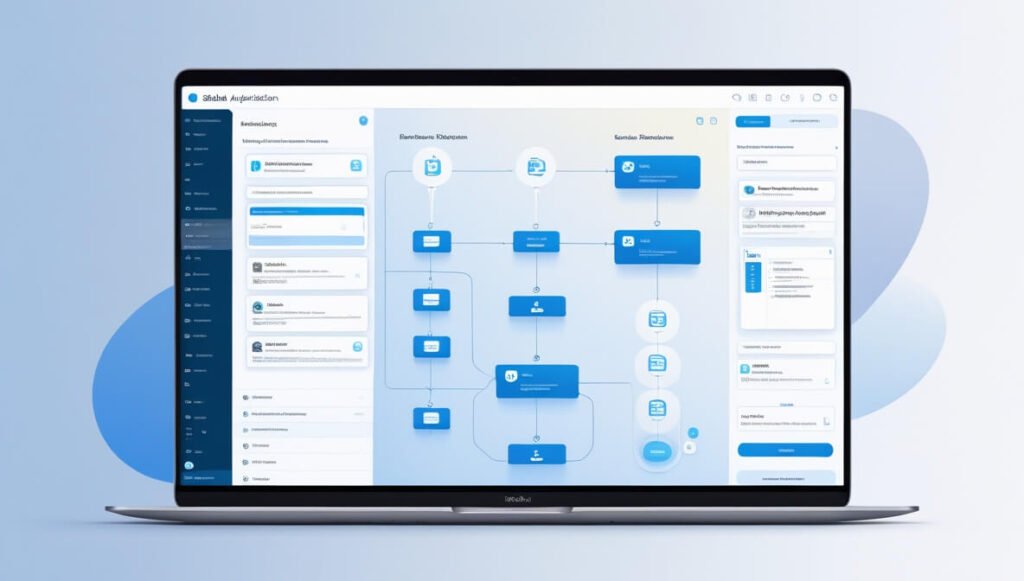Bubble is transforming No Code and Low Code. Build powerful web apps fast, without traditional coding. Stop dreaming, start building – try it today!
Here’s How Bubble Solved My Biggest No Code and Low Code Issue
Let’s talk about building stuff online.
Web apps. Software. The kind of digital products everyone needs but building them used to be a nightmare.
You needed serious coding skills. Like, years of study. Or a team of expensive developers.
It was slow. It was costly. It was a bottleneck for ideas.
Then came the rise of Coding and Developing tools that promised to make things easier. Low code. No code.
They got better, sure. But many still hit walls. Complex logic? Custom features? Forget about it without diving back into code.
That was my biggest problem. I had ideas, big ones, but the tools felt limited.
Until I found Bubble.
It wasn’t just another tool. It was different.
It promised power without the code headaches. The ability to build serious applications.
Could it really solve the complexity issue in the No Code and Low Code space?
I had to see for myself.
Table of Contents
- What is Bubble?
- Key Features of Bubble for No Code and Low Code
- Benefits of Using Bubble for Coding and Developing
- Pricing & Plans
- Hands-On Experience / Use Cases
- Who Should Use Bubble?
- How to Make Money Using Bubble
- Limitations and Considerations
- Final Thoughts
- Frequently Asked Questions
What is Bubble?
Alright, straight up. What is Bubble?
Think of it as a visual programming language. Not just a drag-and-drop website builder.
It lets you design, develop, and launch complex web applications. Full-fledged apps.
Without writing traditional code. No HTML, CSS, JavaScript needed for the core logic.
You build everything visually. Pages, elements, workflows, databases.
It’s aimed at people who want to build software but don’t have the deep Coding and Developing background.
Entrepreneurs with ideas. Product managers validating concepts. Designers building interactive prototypes.
Even developers use it to speed things up. To build MVPs faster than ever.
It handles the backend, the database, the user authentication. All the hard stuff.
You focus on the user interface and the application’s logic. How it works.
It’s one of the most powerful tools in the No Code and Low Code space. Maybe the most powerful.
It gives you control. Real control.
Not just simple landing pages. We’re talking marketplaces, social networks, SaaS platforms.
Apps with user accounts, payment processing, dynamic content.
It provides the foundation. You build the building.
It takes the “code” out of Coding and Developing complex web applications, making it accessible.
That’s the promise. And it delivers.
It’s a platform for builders. For people who want to turn ideas into reality without the typical technical barriers.
It’s not magic, you still have to understand how apps work. Databases, logic.
But you don’t need to know syntax. No semicolons, no curly braces.
Just visual elements and workflows. It’s a different way to build.
A much faster way for many.
It removes a massive hurdle for people in the No Code and Low Code world who want to build something substantial.
That’s Bubble in a nutshell. A serious tool for building serious web apps, code-free.
Key Features of Bubble for No Code and Low Code

Okay, so what makes Bubble special in the No Code and Low Code world?
It’s the features. The things it lets you do without touching code.
- Visual Editor:
This is the core.
You design your user interface by dragging and dropping elements onto a page.
Buttons, text fields, images, forms. All the building blocks.
It feels like design software, but it’s building the actual interface users interact with.
You arrange everything visually. Control layouts, responsiveness.
This removes the need to write frontend code like HTML and CSS. Big time saver.
It’s intuitive once you get the hang of it. You see what you’re building immediately.
Perfect for rapid prototyping and iterating on design.
It’s a game-changer for anyone coming from a design or product background.
- Workflow Engine:
This is where the magic happens.
Workflows define the logic of your application. What happens when a user clicks a button?
You create sequences of actions. Visually.
When this event happens (e.g., button clicked), do these things (e.g., create a user, send an email, navigate to a page).
This replaces backend code and JavaScript logic.
It’s incredibly powerful. You can build complex conditional logic.
Think user registration flows, payment processing, data manipulation.
All built with visual workflows. No code needed here either.
This is why it is more than just a frontend tool. It handles the application logic.
- Built-in Database:
Every real web app needs a database.
It comes with its own.
You define data types (like ‘User’, ‘Product’, ‘Order’).
You define fields within those types (e.g., ‘User’ has ‘Email’, ‘Name’, ‘Password’).
You manage data visually. No SQL commands.
This is crucial. It handles storing and retrieving all your application’s information.
Linking data, querying data, displaying data dynamically on pages.
All managed within the Bubble interface.
This integrates seamlessly with the visual editor and workflow engine.
It means you don’t need a separate database setup. It’s all in one place.
- Plugin System & APIs:
No app lives in a vacuum.
Bubble lets you connect to other services.
There’s a massive plugin marketplace for common integrations (Stripe for payments, AWS for storage, etc.).
You can also connect to almost any API. This means your app can send data to or receive data from other software.
Think integrations with email marketing tools, CRM systems, external data sources.
This is how you extend its capabilities beyond its core.
It’s the low-code part of No Code and Low Code if you need to connect to custom external systems.
But setting up API calls is done visually through the API connector.
No complex code libraries needed.
This opens up a world of possibilities for building sophisticated apps.
Benefits of Using Bubble for Coding and Developing
So, why should you care about Bubble, especially if you’re into Coding and Developing or want to be?
The benefits are massive.
First, speed. Building with it is just faster.
Way faster than writing code from scratch. Prototyping, building MVPs, getting ideas in front of users.
You can build apps in days or weeks that used to take months.
This means you can test market demand quicker. Fail faster, succeed sooner.
Cost reduction is another huge one.
Hiring developers is expensive. Building with Bubble means you might not need a full development team.
You can build it yourself, or hire a specialist who is often more affordable and faster than traditional developers for the same outcome.
Even if you are a developer, using it for certain projects or parts of projects can save tons of time and money.
Accessibility is key.
Bubble opens up software creation to a massive new group of people.
Entrepreneurs, designers, business analysts can now build their own tools and products.
They don’t need to rely solely on technical hires.
Innovation gets a boost.
When building is easier and cheaper, people experiment more.
More ideas get built and tested. This drives innovation in industries.
Flexibility is surprising for a No Code and Low Code tool.
Because of the workflow engine and API connector, It is incredibly flexible.
You can build almost any type of web application you can imagine.
It’s not just template-based static sites. It’s dynamic, interactive applications.
Maintenance is simpler.
Updating features or fixing bugs often means tweaking visual workflows or elements, not digging through lines of code.
This makes ongoing management easier and less prone to introducing new errors.
It empowers non-technical people.
They can take ownership of their digital products. Make changes quickly without needing developer intervention for every little thing.
For those in Coding and Developing, it offers a new way to work.
Build internal tools fast. Prototype client ideas instantly. Focus their traditional coding skills on problems Bubble *can’t* solve, not the routine stuff.
It’s a powerful addition to the toolkit, not necessarily a replacement for all code.
But for many, it’s the easiest path from idea to launched product.
Pricing & Plans

Alright, let’s talk money. Is Bubble going to cost you an arm and a leg?
They have different plans. Like most software these days.
There’s a free plan. Yes, free.
The free plan is great for learning, experimenting, and building.
You can build a full app on the free plan. Design it, build the logic, set up the database.
The main limitation on the free plan is performance and custom branding (you’ll have Bubble branding).
You can’t connect a custom domain, and performance is limited because you’re sharing resources.
But for learning or showing a concept, it’s perfect. No credit card needed to start building.
Then there are paid plans.
These are based on the resources your app uses. Think capacity.
More users, more data, more complex workflows need more capacity.
The paid plans start fairly reasonably for individual builders or small projects.
They scale up for larger, more complex applications with higher traffic.
As your app grows, you pay more for the infrastructure it uses.
This is similar to how you’d pay for server resources if you were hosting a traditional coded app.
The paid plans unlock things like custom domains, increased performance, dedicated capacity, and more features.
Like scheduled workflows, version control, and collaborating with team members.
Compared to hiring a development team or even using some other No Code and Low Code platforms with transaction fees or per-user costs, Bubble’s pricing is competitive.
You’re paying for the power and flexibility you get.
It’s an investment, yes. But one that can be significantly lower than traditional development paths.
Check their site for the latest specifics on each plan, as they do update them.
But the takeaway is: you can start for free, and scale up as your app and needs grow.
It makes the barrier to entry low while allowing for enterprise-level applications.
Hands-On Experience / Use Cases
Enough talk about features. What’s it actually like to use Bubble?
And what can you actually build?
My first time diving in, it felt a bit overwhelming.
The interface is packed with options. Because it *is* powerful.
But the documentation is good, and there are tons of tutorials.
You start with designing a page. Adding elements. It feels familiar if you’ve used design software.
Then you connect elements to the database. Display lists of things. Show details of one thing.
The real “aha!” moment comes with workflows.
Setting up a button click to create a new database entry. Or log a user in.
You see the logic flow visually. It clicks.
I built a simple task management app first. Users, tasks, deadlines.
What would have taken me hours, maybe days, writing code, took maybe an afternoon in Bubble.
Use cases? They’re everywhere.
Internal Tools: Need a custom CRM? A project tracker? An inventory system? Build it in Bubble. Faster, cheaper, and perfectly tailored to your business processes. Companies save serious money building these in-house with this tool instead of buying off-the-shelf or hiring developers.
Marketplaces: Like Airbnb or Etsy? You can build multi-vendor marketplaces. Users signing up, listing items, searching, booking, processing payments (via Stripe plugin). Bubble handles the user types (buyers/sellers) and the complex data relationships.
Social Networks/Communities: Building a platform where users can connect, post content, follow others? Bubble can do it. User profiles, news feeds, commenting, liking, messaging. All possible with the database and workflows.
SaaS Products: Software as a Service. Think subscription-based web applications. Dashboards, user accounts, custom features. Bubble is perfect for building MVPs (Minimum Viable Products) for SaaS ideas. Get it out there, get feedback, iterate fast. This is huge for entrepreneurs.
Booking Systems: For services, appointments, rentals. Managing availability, user bookings, confirmations, payments. Its database and workflow engine are well-suited for this.
Directories and Listing Sites: Building a site listing businesses, events, properties? With search, filtering, user submissions? Bubble handles the data structure and search functionality easily.
The key is that Bubble handles the complexity of web applications. User authentication, database management, handling backend logic.
You focus on the idea, the user experience, and the specific features you need.
It truly lets you build powerful, dynamic web applications without the need for deep traditional coding skills.
My biggest No Code and Low Code issue was always hitting a wall when I needed something slightly custom or complex. It smashed through that wall.
Who Should Use Bubble?

Okay, so who is Bubble actually for?
Is it everyone? Probably not. Is it for a lot of people? Absolutely.
Entrepreneurs: Got a web app idea? Bubble is your best friend. Build your MVP without needing a technical co-founder or blowing your seed money on developers. Validate your idea quickly and cheaply.
Startup Founders: Need to build your product fast? Iterate based on user feedback? Bubble allows rapid development cycles. Perfect for getting traction before scaling up.
Small Business Owners: Need a custom tool to manage leads, track inventory, or handle bookings? Stop using spreadsheets or expensive, clunky software. Build exactly what you need in Bubble.
Product Managers: Want to test a new feature or a whole new product concept? Build a working prototype or an MVP quickly to gather real user feedback. Communicate ideas visually with a working app.
Designers: Tired of static mockups? Bring your designs to life with a fully interactive application. Test user flows and experiences in a live environment.
Marketers: Need landing pages with complex forms or user segmentation? Want to build a custom tool for campaigns? It gives you the power to build dynamic marketing assets beyond standard tools.
People Learning Coding and Developing: Bubble is a great way to understand how web applications work – databases, frontend, backend logic – without getting bogged down in syntax. It’s a fantastic bridge.
Freelancers/Agencies: Build web applications for clients faster and more affordably than traditional development. Offer custom solutions without needing a large development team.
Educators: Teach application development concepts visually and interactively. Bubble makes building software understandable.
If you have an idea for a web application and you’re not a seasoned full-stack developer (or even if you are and want to move faster), it is likely for you.
It requires logical thinking and a willingness to learn a new platform.
But it removes the major barrier of writing and managing code.
It’s for builders who want to build software without the traditional coding grind.
How to Make Money Using Bubble
Okay, let’s talk brass tacks. Can you actually make money with Bubble?
Absolutely. Bubble isn’t just a tool for building your own thing. It’s a skill. And skills make money.
There are multiple ways to turn your Bubble abilities into income.
- Service 1: Build Applications for Clients:
This is the most direct route.
Many businesses need custom web apps but don’t have the budget or time for traditional development.
Offer your services as a Bubble developer.
Build internal tools, client portals, marketplaces, membership sites.
Because you can build faster, you can charge competitive rates and take on more projects.
This is basically running a web development agency, but powered by Bubble.
Demand for skilled Bubble developers is growing rapidly.
- Service 2: Sell Bubble Templates and Components:
If you get good at building common features or app types, package them up.
You can build reusable templates for specific niches (e.g., a booking app template, a directory template).
Or build specific components (e.g., a fancy signup form, a complex filtering system) as plugins.
Sell these on marketplaces dedicated to Bubble resources.
This creates passive income based on your building expertise.
- Service 3: Offer Maintenance and Consulting:
Once apps are built, clients often need ongoing support.
Offer maintenance packages to keep their Bubble app updated and running smoothly.
Provide consulting services for businesses considering or using Bubble.
Help them plan their app, troubleshoot issues, or improve performance.
Your expertise becomes a valuable asset.
Build and Sell Your Own Products:
Forget client work for a minute. Use Bubble to build your own SaaS product.
Identify a problem, build a solution with Bubble, and charge users a subscription fee.
This is how many successful No Code and Low Code entrepreneurs got started.
You control the product, the revenue, everything.
It requires marketing and sales skills too, but Bubble removes the initial development barrier.
Increase Efficiency in Your Current Job:
Even if you don’t freelance, using Bubble to build internal tools or automate workflows at your job makes you incredibly valuable.
Saving your company time and money translates to career growth and potentially higher pay.
Look at someone like Lacey Kesler. She built a successful business, Bubble.io Tutorials, teaching others how to use Bubble and offering development services. She’s a prime example of turning Bubble skills into significant income.
Whether you want to freelance, build products, or just be more valuable in your current role, Bubble provides the tools to make it happen.
Limitations and Considerations
Is Bubble perfect? No. No tool is.
There are things to keep in mind before jumping in headfirst.
Performance:
For extremely high-traffic applications with complex real-time interactions, you might hit performance limits compared to a highly optimized, custom-coded solution on dedicated servers.
Bubble is constantly improving performance, but it’s a consideration for massive scale.
Learning Curve:
While it’s No Code and Low Code, it’s not brainless.
You still need to understand database concepts, application logic, and how web apps generally work.
The visual interface and workflow engine are powerful, but they take time to learn effectively. It’s a steep hill initially, but rewarding once you climb it.
Vendor Lock-in:
Your application is built *on* the Bubble platform.
While you can export your data, you can’t easily export the entire application logic and design to run on a different hosting provider or technology stack.
You are reliant on Bubble as your platform. This is a trade-off for the speed and ease of building.
Design Flexibility (compared to code):
While the visual editor is flexible, pixel-perfect design control can sometimes be more challenging than writing custom CSS.
Achieving highly unique or complex user interfaces might require more workarounds or plugins than coding.
SEO for Public-Facing Sites:
Building SEO-friendly public websites is possible with Bubble, but requires careful setup.
Things like server-side rendering for initial page loads can be a consideration for content-heavy sites where SEO is paramount.
Debugging:
Debugging workflows and logic can sometimes be tricky.
Understanding why a workflow isn’t firing correctly or why data isn’t displaying can take some detective work within the Bubble debugger.
These aren’t reasons to avoid Bubble, but they are realities.
No tool is a silver bullet.
Understanding these limitations helps you choose the right tool for the job and manage expectations.
For 90% of the web applications people want to build, Bubble is more than capable and the benefits far outweigh these considerations.
Final Thoughts
So, where does Bubble fit in the world of Coding and Developing, especially with No Code and Low Code on the rise?
It’s not just another tool. It’s a fundamental shift.
It democratises software creation.
It takes the power to build complex web applications and puts it in the hands of way more people.
My biggest headache with No Code and Low Code was always the ceiling.
You could build simple stuff quickly. But anything complex? You needed code.
Bubble blew that ceiling off.
It lets you build almost anything a traditional coded app can do, just visually.
From simple internal tools to complex marketplaces.
It’s fast, it’s flexible, and it’s powerful.
Is there a learning curve? Yes. Does it have limitations? Yes.
But the ability to go from idea to launched, functional web application without writing code is immense.
For entrepreneurs, for product builders, for anyone who needs custom software but isn’t a developer, Bubble is a game-changer.
Even for developers, it’s a tool to build faster, prototype quicker, and focus on the truly hard problems.
If you have a web app idea gathering dust because you thought you needed to learn Python or Ruby on Rails for two years, stop.
Look at Bubble.
It might just be the solution you needed to finally build it.
Visit the official Bubble website
Frequently Asked Questions
1. What is Bubble used for?
Bubble is used to build web applications.
Think dynamic websites with user accounts, databases, and complex logic.
Examples include marketplaces, social networks, SaaS products, internal tools, and booking systems.
It’s for building functional software, not just static websites or landing pages.
2. Is Bubble free?
Yes, Bubble offers a free plan.
The free plan lets you build and test your application fully.
Paid plans are available for launching with a custom domain, increased performance, and more features.
3. How does Bubble compare to other AI tools?
Bubble is different from AI tools that generate text or images.
Bubble is a development platform that uses a visual interface and workflow engine to build software applications without traditional coding.
It’s in the No Code and Low Code space, focused on application building, whereas many AI tools are content generation or analysis focused.
4. Can beginners use Bubble?
Yes, beginners can use Bubble.
It has a learning curve, but it doesn’t require prior coding knowledge.
You need to learn the platform’s interface, database structure, and workflow logic.
There are many tutorials and resources available to help beginners get started.
5. Does the content created by Bubble meet quality and optimization standards?
Bubble doesn’t create content in the traditional sense (like articles or images).
It builds the structure and logic of web applications.
The quality and optimization of the *application itself* depend on how well you design and build it using Bubble’s features, including setting up SEO parameters.
6. Can I make money with Bubble?
Absolutely. You can make money by building applications for clients as a freelancer or agency.
You can also build and sell your own software products (SaaS).
Selling templates and components on marketplaces is another option.
Bubble skills are in demand.






